Photo editing is a global hobby, profession, and exploit. Its execution is not dependant on a specific Operating System or device. For this reason, anyone can be a photo editor regardless of their Operating system preference. The power of an ideal and reliable photo editor is in the many unique features they present to their users. Some features pose unique photo editing benefits like correcting brightness imbalances and color hue. Some editors are efficient in sharpness adjustments and red-eye removal. Others present flexible auto-cropping and zoom features. These are some of the characteristics that define a photo editor.
The earlier onset of the Linux operating system was without the support of photo editors. This trait forced most Linux users to depend on graphically-oriented Operating Systems like the Windows OS to meet their photo editing needs. Fast forward into the present, Linux OS is turning out to be a worthwhile opponent and an even better rival to other Operating Systems due to the graphical traits presented in its growing distributions and flavors.
Top 10 free photo editors for Linux
For this reason, we are here to list down the various photo-editing software every Linux user can expect to leap without the need to consult other graphically endowed operating systems.
1. GIMP photo editor

GIMP Photo Editor
GIMP is the first candidate on this list because of its growing popularity. Its reputation can now boldly be compared to the likes of Adobe Photoshop because of the evolutionary footprints that accompany its photo editing features. This milestone makes it a cross-platform photo editor. Other Operating System users can also benefit from it. It is a free, extensible, open-source, and flexible photo editor. GIMP being a prime photo editor does not limit its applicability to hobbyists alone. Photographers, scientists, graphic designers, and illustrators also find this photo editing tool’s features to be priceless.
The extensive trait we just mentioned regarding GIMP applies to its support for third-party plugins. These plugins make it customization in its photo editing functionality. The features it presents to the Linux users audience include the following:
Expect high-quality photo manipulation. The featured tools packaged with this photo editing app are responsible for this high-quality image manipulation trait. GIMP gives you the power to manipulate images to the limit of your imagination. You can retouch, restore, or create composites, and it is up to you and the photo manipulation approach you feel best works for your project.
With GIMP, you can give a dull image a stroke of life. This feature is ideal for artists and creators. You will be able to develop unique creations through the flexibility and transformative nature of this platform.
You will be able to create graphic design elements. You might need graphical design elements, icons, or artwork for your website-based or desktop-based projects. GIMP gives you the option of creating these useful elements to better your projects.
Its multi-language support for programming algorithms through the likes of Python, Pearl, C++, and C programming languages makes it a reputable scripted image manipulation framework.
Lastly, its color management features are unmatched and guarantee that your digital and print media maintain high-fidelity color reproduction.
2. Krita photo editor
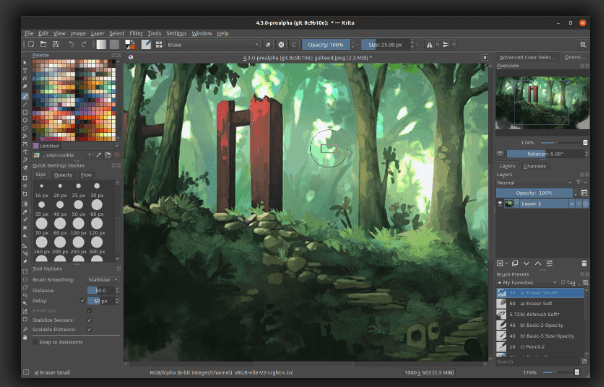
Krita free and open-source photo editor
If you want your photo editing pursuit to have a professional and creative touch, you should consider using the Krita photo editor. It is an open-source photo-editing tool supported by Linux but also extends to other Operating System platforms. Its User Interface is intuitive, flexible, and clean. Its application extends to comics, illustrations, texture and matte painters, and concept art. This photo editor’s notable unique flexibility is in the user interaction it presents for commonly used tools. It lets you create a shortcut to your favorite tools so that you do not have to adapt to a navigate routine to hidden sub-menus to access these tools.
If you are a user with a theme preference, you will be able to choose between Krita’s dark and light themes comfortably. It also extends its functionality through its more than 30 dockers.
Krita comes with more than 100 professional and beautiful brushes. They attribute a range of effects that are contributive to your photo editing routines.
This photo editor also presents the usefulness of brush stabilizers. Not all of us have a firm grip on making useful brush strokes on a photo editor’s interface. Brush stabilizers smoothen the effects of our shaky hands. With Krita, you have three approaches to smoothen and stabilize your brush strokes.
The tool also offers a built-in vector and text tool that is assistive in creating comic panels. It provides a vector library from which you can choose a word bubble template for your canvas. You will then be able to facilitate the creation of shapes and libraries from different anchor points.
3. Pinta photo editor

Pinta free and open-source photo editor
If you are familiar with Windows Operating System’s Paint.NET, Pinta should not be a stranger to you as it mocks the same functional delivery approach as Paint.NET. You can think of this photo editor as a Linux-based Windows paint version, but this statement does not dismiss the fact that it is also supported on other Operating System platforms. If your photo editing routines do not require too much studying of a photo editor’s interface, then you will love what Pinta has to offer. It is simple to master and understand its interface navigation and photo editing menu, and within no time, you will have completed your photo editing objective.
A breakdown of this photo editor’s basic features starts with its multilingual support. It exists in over 55 language translations, making it ideal for Linux users from different regions.
The photo editor offers 35 adjustments and effects. With this feature, you have more than enough alternatives for tweaking your images.
Its drawing tools include a variety of easy-drawing tools that cater to the creation of eclipses, rectangles, lines, and also freehand drawing support.
As for its advanced features, it has a Full History feature that tracks all your photo editing steps from the moment you make your first photo edit attempt. You do not have to worry about undoing your photo editing steps to the first baby step.
Pinta offers multiple layers making it easy to group and separate your image elements for effective editing.
Finally, your workplace on this editor offers support for both docked windows and floating windows.
4. DigiKam photo editor

DigiKam free and open-source photo editor
DigiKam stands out as an advanced and professional software application for a free and open-source photo editor and photo manager. It also extends its compatibility and support to other operating systems like macOS and Windows. It empowers its users to import, manage, edit, and share raw files and photos. If we understand its features properly, we have to look at the photographic workflow it offers. The first stage involves setting up your raw files, videos, or photo collections. You will then need to import these raw files, videos, or photos to organize the setup collections. The next step that follows is searching and sorting through your collections through browsing, comparing, and viewing your collection items. You will then post-process, edit, assemble and transform these raw files, videos, and photos if necessary. Finally, you can decide to share your published photos.
You do not have to immediately memorize these steps as DigiKam comes with a tutorial directory to walk you through these steps. Another exciting feature offered by this app is facial recognition support. Once you are done with your photo editing project, you can export the finished project files to various formats it supports. Alternatively, you can import raw project files to a file format you find comfortable.
5. ShowFOTO photo editor
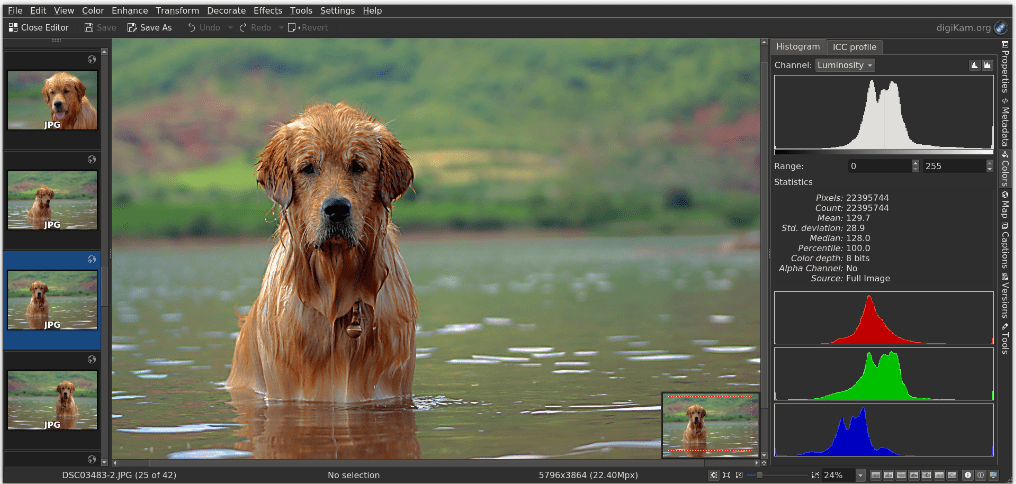
ShowFOTO free and open-source photo editor
If you are looking for a fusion of power and image editing, look no further than the ShowFOTO image editor. Based on the DigiKam project, this app was intentionally designed to be a standalone photo and image editor. This statement implies that ShowFOTO is perfectly functional on its own and does not require the support or input of third-party apps to give it the required performance efficiency.
You can open or upload an image file to this platform and use a variety of its powerful tools to improve the outlook of these images if necessary. Some of its effective functionalities include metadata editing, filtering, adding effects, and image transformation. It might not be feature-rich like some of the previously reviewed free photo editors, but its effective performance and lightweight nature make it worth your time.
6. RawTherapee photo editor
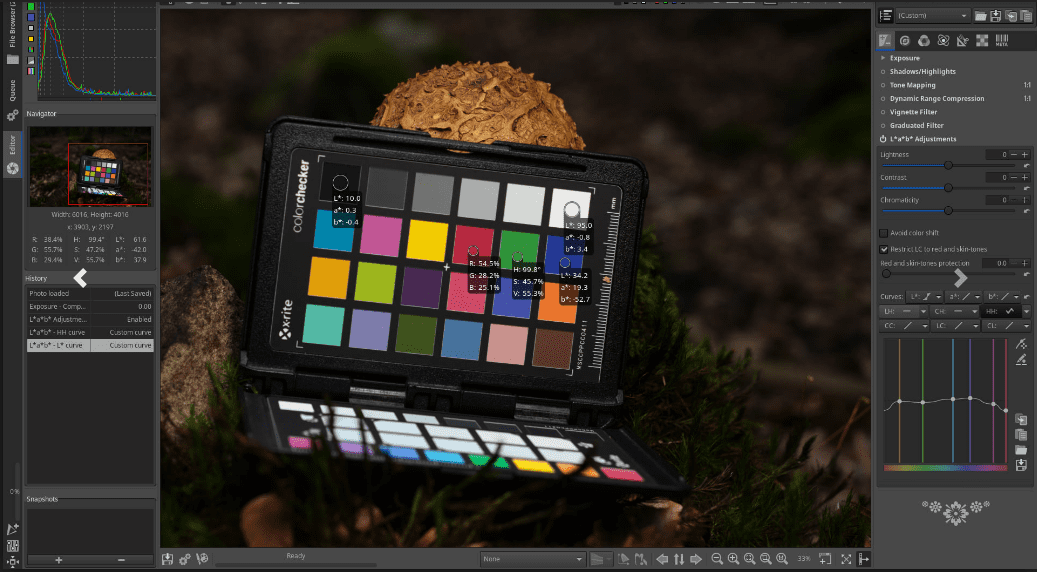
RawTherapee free and open-source photo editor
This image processing program is free, open-source, and cross-platform. It extends its image editing expertise to Windows and macOS operating systems platforms. Its official website even offers you the source code for this awesome photo editing app for you to play around with. It is because its release to the public domain is supported by GPL3 Free Software license. RawTherapee is the perfect platform for understanding how raw files are developed from varying digital cameras.
Whether you are a photo editing newcomer or enthusiast, this platform is friendly enough to broaden your scope and understanding of the world of digital imaging. If you can master the use of RawTherapee photo editor, then the only thing separating you from a professional photographer will be the lens pixel range on the digital camera being used.
The photo edits you can produce from this platform are beyond amazing, making it the perfect portfolio-landscape for showcasing your creative works. To reach such photo editing perfection levels, you will need to adhere to the rule of practice that makes perfect. A shortcut to bypassing this rule is through the helpfulness of its growing community support that will answer any question you have to pose.
As for its advanced features, we have its use of modern demosaicing algorithms and color+detailing editing for the development of the highest image quality. It also operates under a 32-bit floating-point and non-destructive processing engine. It implies that this photo editor will not crash or hang during your photo editing sessions. Other useful features include color adjustment, parallel editing, exposure control, optional use of secondary display, and metadata editing.
7. Fotoxx photo editor

Fotoxx free and open-source photo editor
Fotoxx is not only an open-source and cost-free photo editor. It also functions perfectly as a collection management tool. If you are a dedicated photographer that is looking for a photo app that portrays speed, simplicity, and easiness in its photo editing maneuvers, then you should consider what Fotoxx has to offer.
With its photo collection management feature and functionality, your photo editing project collection directories become easy to navigate through to their internal sub-directories structure through the use of a thumbnail browser. A quick overview of its unique features include the following:
- photo transformation through simple computer mouse clicks
- numerous techniques and approaches to performing photo retouches
- artistic photo transformation support to realistic animations
- use of metadata as one of the alternative ways of accessing your saved or completed project work.
8. Inkscape photo editor

Inkscape free and open-source photo editor
This photo editor is not only free and open-source but also cross-platform. Inkscapes’ vector graphics editor is feature-rich. We can confidently compare its design and functional presentation to the famed Adobe Illustrator application software. No matter the illustrations you want your project to achieve, be it artistic or technical, Inkscape will empower you to create those flowcharts, diagrams, typography, logos, cartoons, and clip arts to your satisfaction.
Some of its marketable features include its extensible nature that allows Inkscape to support the use of add-ons. Its User Interface is simple enough for you to import and export your image editing project files comfortably. It offers multi-lingual support making it acceptable to users from different regions and localities around the world. The file formats it supports include PNG, PDF, AI, SVG, EPS, and PS.
9. LightZone photo editor
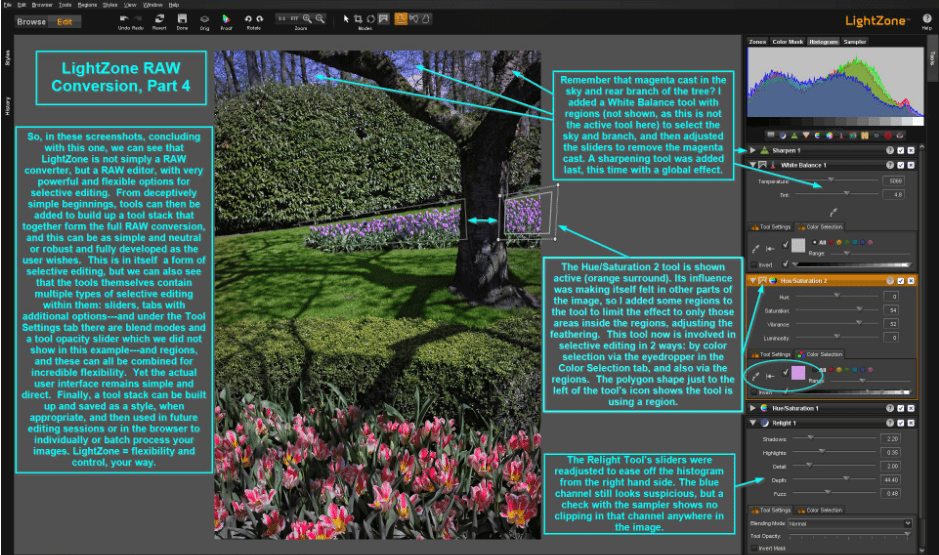
lightZone free and open-source photo editor
The professional-grade nature of this free and open-source digital darkroom software had initially forced users to register on its official site before accessing and reaping the fruits of the functional features it has to offer. The continuous growth in demand for this photo editing app dismissed this necessity. You only need to register on its official site if you need forum access to its growing user community support. Its operating system support is cross-platform. It offers raw digital file processing and editing. LightZone’s photo editing session does not employ the use of layers. It enables users to re-arrange, re-adjust, turn OFF and ON, and remove editable project files from a build-up stack.
10. Photivo photo editor
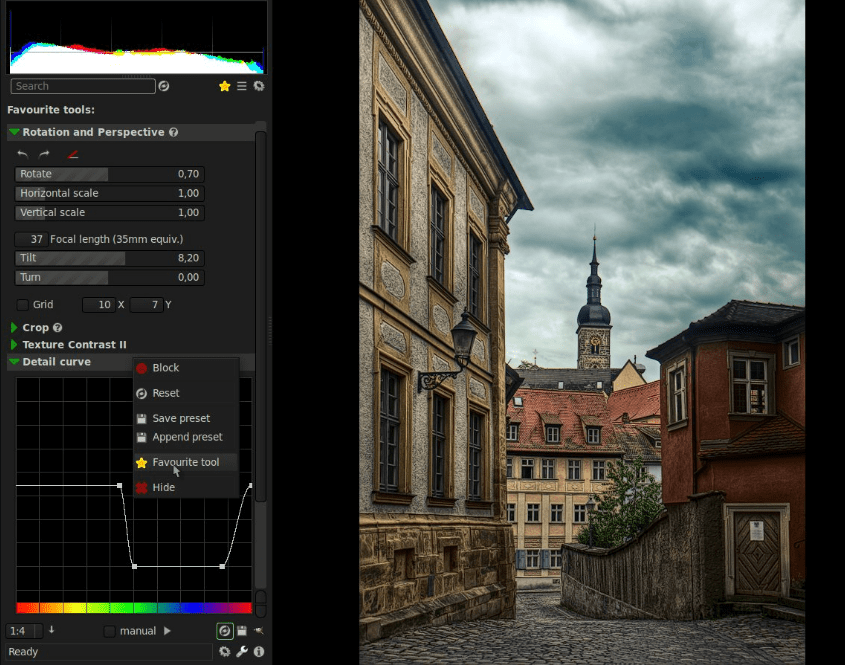
Photivo free and open-source photo editor
This photo editor is another free and open-source application software to consider. If you find yourself dealing with mostly 16-bit precision bitmaps and raw images, this powerful photo processor is perfect for your consideration. It is supported by other operating systems making it a cross-platform photo application.
The Photivo app is not user-friendly to beginners in the photo editing world. It has something to do with its steep learning curve. Also, the hardware and graphical specs of the machine you use to run Photivo need to be above average in performance. It will enable you to enjoy a smooth photo editing flow. Besides these few rules, Photivo sets for us; you are guaranteed an enjoyable photo editing time if you master and give this app a try.
Final note
The choice of the photo editing application software you go with is always pre-determined by your photo editing projects’ objective. You will have to keep in mind the file formats you will be using for the photo editing projects and if the photo editor of your choice supports these file formats. Your machine’s performance is also important as the photo editor you decide to go with should not struggle to perform on a machine with limited performance specs.
The Linux world is now happy as we have more than enough photo editors at our disposal, unlike recent times. Free and open-source photo editing couldn’t get more exciting!


1 comment
Links to the products would be good.